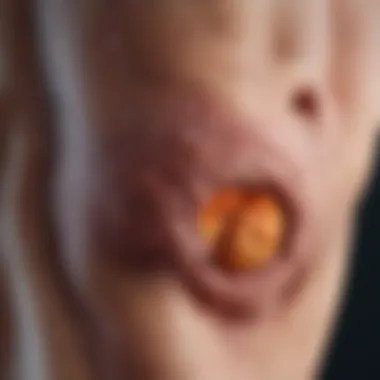Understanding Hyperechogenic Liver: Insights and Implications


Intro
Hyperechogenic liver refers to an increase in echogenicity observed in liver imaging. It often indicates an underlying condition affecting the liver's structure or function. Understanding this concept is vital for professionals in the medical field as it provides insights into the liver's health and potential diseases. This overview will detail key findings, implications, diagnostic methods, and treatment options related to hyperechogenicity in the liver.
Research Overview
Summary of Key Findings
Hyperechogenicity can arise from several factors, such as hepatic steatosis, fibrosis, or malignancy. Research has shown that imaging techniques, particularly ultrasound, are crucial in detecting these changes in liver texture. Studies emphasize that a hyperechogenic liver is often a precursor to more severe liver conditions, such as cirrhosis or liver cancer.
Importance of the Research in Its Respective Field
The implications of studying hyperechogenic liver are profound. Identifying these characteristics early can lead to timely interventions and management strategies that significantly improve patient outcomes. Furthermore, as imaging technology advances, the accuracy of detecting liver pathologies continues to enhance.
Methodology
Description of the Experimental or Analytical Methods Used
To study hyperechogenic liver, researchers typically rely on a combination of imaging techniques and histological examinations. Ultrasound remains the primary modality due to its non-invasive nature and widespread availability. Some studies may incorporate magnetic resonance imaging (MRI) or computed tomography (CT) for more detailed evaluations. Lab tests, such as liver function tests, can also provide valuable complementary data.
Sampling Criteria and Data Collection Techniques
Participants in studies are often selected based on specific criteria, including age, existing liver conditions, and imaging findings. Data collection methods might involve retrospective chart reviews, longitudinal studies, or case-control designs. By analyzing a diverse patient population, researchers can better understand the different causes of hyperechogenicity and their clinical significance.
Defining Hyperechogenic Liver
Hyperechogenic liver refers to a condition visible in ultrasound imaging where the liver appears brighter than normal. This brightness often indicates the presence of specific pathologies or changes in the liver's composition. Understanding this concept is crucial for healthcare professionals, as it helps in diagnosing underlying liver conditions and assessing their severity. The hyperechogenicity can arise from various etiologies, including hepatic steatosis, fibrosis, or other diseases that alter liver structure. In medical imaging, recognizing these changes allows practitioners to take appropriate action early in the disease process.
Key Characteristics
Hyperechogenic liver has distinct characteristics observable in imaging studies. Firstly, the echogenicity of the liver can be compared with surrounding structures, such as the kidneys, which usually have a different echogenic pattern. The hyper-echoic appearance does not remain static; it can be influenced by various factors, including the patient's hydration levels and acoustic windows during ultrasound.
Other important features include:
- Increased Liver Size: Often, a hyperechogenic liver may also present with hepatomegaly.
- Inhomogeneous Texture: The echogenicity may not be uniform, which can imply varying degrees of pathology within the liver.
- Indications of Fatty Infiltration: Increased echogenicity is frequently associated with fatty liver disease, where fat accumulates within hepatocytes.
The identification of these key characteristics plays an essential role in guiding further diagnostic evaluations and management strategies.
Clinical Significance
The clinical significance of hyperechogenicity in the liver cannot be overstated. It serves as an early indicator for numerous hepatic conditions that could lead to significant health problems if left undiagnosed. For example, hyperechogenicity might signal hepatic steatosis, a precursor to more severe conditions such as non-alcoholic fatty liver disease or cirrhosis.
"Recognizing a hyperechogenic liver is a critical step in the diagnostic process, guiding healthcare professionals toward potential underlying conditions."
Moreover, understanding the implications of a hyperechogenic liver assists clinicians in planning suitable interventions, whether through lifestyle modification, pharmacotherapy, or surgical options. Regular monitoring of patients with hyperechogenic livers is often warranted to evaluate the progression of liver disease and to adjust treatment plans accordingly.
In summary, defining hyperechogenic liver lays the groundwork for understanding complex liver conditions. This knowledge translates into better patient care and outcomes.
Etiology of Hyperechogenicity
Understanding the etiology of hyperechogenicity is essential in this discussion. It helps to identify underlying liver diseases and conditions, paving the way for appropriate management and treatment options. This subsection focuses on specific factors contributing to the hyperechogenic appearance in liver imaging. Each cause reveals insights that can improve diagnostic accuracy and patient outcomes.
Fatty Liver Disease
Fatty liver disease, known medically as hepatic steatosis, is often a primary cause of hyperechogenicity. In this condition, excess fat builds up in liver cells, leading to an increased echogenic appearance during ultrasound examinations. This condition can be alcohol-related or non-alcoholic.
Non-alcoholic fatty liver disease (NAFLD) has gained prominence due to its rising prevalence in the global population. Risk factors for NAFLD include obesity, diabetes, and metabolic syndrome. The significance of early detection is paramount. Fatty infiltration of the liver can progress to inflammation and fibrosis if not appropriately managed. Regular imaging and lifestyle changes are pivotal in enhancing liver health in affected individuals.


Chronic Hepatitis
Chronic hepatitis, particularly from viral infections like Hepatitis B and C, also contributes to hyperechogenicity. Inflammation induced by the virus leads to cellular damage and changes in liver tissue architecture.
Persistently elevated liver enzymes and imaging results reveal increased echogenicity as the disease progresses. Monitoring patients with chronic hepatitis is crucial. Interventions can reduce liver damage and prevent complications such as cirrhosis and liver cancer. Early diagnosis through imaging plays a vital role in managing such cases, helping to establish clear treatment pathways.
Fibrosis and Cirrhosis
Both fibrosis and cirrhosis signify advanced stages of liver disease and are associated with marked hyperechogenicity. Fibrosis represents scarring of liver tissue due to a variety of insults, including chronic alcohol use and viral hepatitis. If the inflammation persists, it can lead to cirrhosis, where liver function is severely impaired.
Each of these conditions can alter the normal echogenicity of the liver extensively, making it vital for practitioners to recognize and evaluate these changes. The assessment also helps in staging the disease, which is critical for determining the prognosis and treatment options available—ultimately leading to improved patient care.
Invasive Liver Disorders
Invasive liver disorders encompass a range of conditions such as liver tumors and abscesses that can also manifest as hyperechogenicity on imaging. These anomalies can be benign or malignant, requiring careful evaluation.
The presence of tumors may complicate the clinical picture. Scanning technologies must be used to differentiate between types of lesions accurately. Timely diagnosis of such invasive diseases is essential for the initiation of targeted therapies, which can significantly influence outcomes. Understanding the etiology behind hyperechogenicity connects imaging findings to underlying pathology, providing a comprehensive approach to liver health.
Imaging Techniques for Diagnosis
Imaging techniques play a critical role in diagnosing hyperechogenic liver. The right imaging modality can provide vital insights into the liver's condition, helping healthcare professionals to identify underlying issues that might not be evident through physical examination alone. Accurate imaging helps evaluate the degree of hyperechogenicity, which can be indicative of various liver pathologies, including fatty liver disease, inflammation, or fibrosis. Proper imaging techniques minimize the potential for misdiagnosis and allow for timely intervention and appropriate management.
Ultrasound as a Primary Tool
Ultrasound stands out as the initial imaging choice for assessing the liver. This non-invasive method is widely available and cost-effective. Ultrasound uses sound waves to create real-time images of the liver tissue. When evaluating hyperechogenicity, altered echogenic patterns can signal the presence of fat, inflammation, or fibrosis.
Key advantages of using ultrasound include:
- Safety: Since it does not involve radiation, ultrasound is considered safe for patients, making it suitable for various populations, including pregnant women.
- Real-time imaging: Physicians can visualize liver structures dynamically, aiding in guided biopsies if needed.
- Accessibility: Availability in many clinical settings allows immediate assessment during the patient visit.
Moreover, ultrasound can help monitor changes over time. Regular ultrasounds can allow physicians to track disease progression or regression in hyperechogenic liver.
CT Scans for Further Evaluation
When ultrasound findings suggest significant abnormalities, a CT scan becomes valuable for further evaluation. Computed Tomography (CT) offers superior cross-sectional imaging that provides more detail than ultrasound. It can more clearly depict liver size, contour, and vascular structures.
CT scans can assist in:
- Identifying lesions: Detecting focal lesions such as tumors or cysts is more reliable with CT imaging than ultrasound.
- Assessing liver density: Measuring liver density quantitatively helps differentiate between fatty liver and other pathologies like cirrhosis or malignancies.
- Evaluating complications: In cases where liver disease leads to complications such as portal hypertension, CT scans provide crucial information.
However, one must consider the use of contrast agents in CT scans, as some patients may have adverse reactions, or certain conditions may contraindicate their use.
MRI: Advanced Imaging Options
Magnetic Resonance Imaging (MRI) offers the most advanced imaging option for the liver. It provides high-resolution images without the use of ionizing radiation, which is an advantage over CT scans. MRI can be exceptionally beneficial in evaluating liver conditions with intricate details.
Some specific areas where MRI excels include:
- Characterization of lesions: MRI can differentiate between benign and malignant lesions more effectively due to its ability to assess tissue characteristics and blood flow.
- Fat quantification: Advanced MRI techniques can quantify fat content within the liver, helping to determine the severity of fatty liver disease.
- Liver function assessment: Certain MRI sequences can evaluate liver perfusion and function, offering insights beyond anatomical detail.
While MRI is invaluable, it is more expensive and less available compared to ultrasound and CT, which may limit its application in certain clinical settings. Nonetheless, it remains a key component in the imaging evaluation of hyperechogenic liver, especially in complex cases or when other imaging results are inconclusive.
Histological Analysis
Histological analysis plays a crucial role in the evaluation of a hyperechogenic liver. By examining liver tissue at the microscopic level, healthcare professionals can identify changes in cellular structure and composition that may indicate underlying pathologies. This technique offers valuable insights that imaging techniques alone may not reveal. Histological examinations help in confirming diagnoses and determining the stage of liver diseases, which is essential for establishing effective treatment plans.
Tissue Biopsy Techniques
Tissue biopsy is a fundamental technique for obtaining liver samples for histological analysis. There are several methods to perform a liver biopsy. One common approach is the percutaneous biopsy, where a thin needle is inserted through the skin into the liver. Guided by imaging, like ultrasound, this method often yields sufficient tissue for examination. Another method is the laparoscopic biopsy, performed during surgery. This technique allows for direct visualization of the liver to obtain samples from areas of interest. The choice of biopsy method depends on the patient's condition and the clinical indication.


Benefits of Tissue Biopsy:
- Provides definitive diagnosis by enabling histological examination.
- Helps to assess the degree of inflammation, fibrosis, or malignancy.
- Can inform treatment choices, especially in cases of chronic liver diseases.
Pathological Findings
The analysis of biopsy samples can lead to several significant pathological findings. Commonly observed conditions include steatosis, inflammation, and fibrosis. Steatosis, or fat accumulation in liver cells, is often present in cases of fatty liver disease. Inflammation can indicate chronic hepatitis or other liver diseases. Fibrosis results from the liver's response to injury, and its extent is clinically significant as it may lead to cirrhosis over time.
Analyzing these findings involves looking at the liver architecture and cellular changes. Histological stains, such as hematoxylin and eosin, are utilized to enhance visualization of specific features. Additionally, more specialized staining techniques can help detect fibrosis or inflammation. Understanding these findings is essential in predicting disease progression and tailoring treatment.
In summary, histological analysis provides critical information that helps to elucidate the nature and extent of liver pathology.
Practitioners must integrate histological findings with clinical data for a comprehensive evaluation of liver health. This approach enhances diagnostic accuracy and ultimately improves patient outcomes.
Association with Systemic Conditions
The association between hyperechogenic liver and systemic conditions is a critical theme in this article. Understanding this relationship is essential because it reflects broader health implications. Hyperechogenicity seen in liver imaging is often not an isolated finding but may point to underlying systemic metabolic issues. Recognizing these connections helps healthcare professionals identify potential complications early and can guide management strategies effectively.
Diabetes Mellitus
Diabetes mellitus significantly impacts liver health. Insulin resistance, which is a key feature of type 2 diabetes, can lead to the development of non-alcoholic fatty liver disease (NAFLD). In this context, the liver accumulates excess fat, which can contribute to hyperechogenicity on imaging studies.
- Prevalence: Individuals with diabetes often exhibit a higher prevalence of hepatic steatosis.
- Liver Enzymes: Elevated liver enzymes are common in diabetic patients, indicating potential liver damage due to fat accumulation.
The attention to liver echogenicity in diabetes management is vital, as addressing this can lead to improved overall outcomes. Effective control of blood sugar levels, along with lifestyle changes, can potentially reverse the hyperechogenic changes seen in some patients.
Metabolic Syndrome
Metabolic syndrome encompasses a cluster of conditions including obesity, hypertension, dyslipidemia, and insulin resistance. Each of these elements can contribute to the development of a hyperechogenic liver.
- Fatty Infiltration: The accumulation of fat in the liver is one of the hallmarks of metabolic syndrome, resulting in higher echogenicity on ultrasound.
- Systemic Inflammation: This syndrome is associated with chronic inflammation, which can further exacerbate liver damage.
Recognition of the liver's echogenicity within the framework of metabolic syndrome emphasizes the need for comprehensive management strategies. Addressing the entire syndrome, rather than isolated components, promotes better liver health and overall well-being.
Understanding the systemic associations of hyperechogenic liver is paramount for early diagnosis and effective treatment.
Symptoms and Clinical Presentation
Understanding the symptoms and clinical presentation of hyperechogenic liver is crucial for accurate diagnosis and management of the condition. The liver's echogenicity, or brightness on imaging tests, can indicate various underlying issues, making it imperative for health professionals to recognize and interpret these signals effectively. Recognizing the symptoms associated with hyperechogenicity is a key element in identifying liver disorders early, allowing for timely intervention and better patient outcomes.
Common Symptoms
In cases of hyperechogenic liver, patients may exhibit a range of symptoms. Some common signs include:
- Fatigue: Many individuals report feeling unusually tired, which may not be attributable to other causes.
- Abdominal discomfort: Often, patients experience pain or discomfort in the upper right quadrant of the abdomen.
- Nausea: This may accompany other gastrointestinal symptoms like bloating or a reduced appetite.
- Weight loss: Unintentional weight loss can also occur.
- Jaundice: A yellowing of the skin and eyes may signal liver dysfunction.
These symptoms can sometimes be subtle. However, recognizing them can lead to further investigation, which is essential given that a hyperechogenic liver may signify more serious underlying conditions like fatty liver disease or fibrosis.
Asymptomatic Cases
It is important to note that not all patients with a hyperechogenic liver will present with noticeable symptoms. Many individuals may remain asymptomatic even when imaging studies indicate abnormalities. This situation is particularly relevant when the underlying cause is early-stage fatty liver disease or minor fibrosis.
The asymptomatic nature of these cases poses a significant challenge in clinical practice. Healthcare providers must be aware that:
- Routine imaging might sometimes reveal hyperechogenicity without any clinical symptoms.
- Regular monitoring is essential in these instances, as asymptomatic cases can progress to more severe liver disease without any warning signs.
- Health care professionals should consider patient history and risk factors to decide on the necessity of follow-up imaging or investigation.
Asymptomatic presentations of hyperechogenic liver can lead to delayed diagnosis. Awareness and proactive monitoring are essential.


In summary, the clinical presentation of hyperechogenic liver varies widely among individuals. Symptoms can range from pronounced fatigue to complete absence of signs, making continuous education about these variations critical for successful diagnosis and management.
Management and Treatment Approaches
The management and treatment of a hyperechogenic liver are critical for minimizing potential complications and enhancing patient outcomes. Recognizing the variations in underlying causes informs tailored treatment strategies. As health professionals navigate the complexity of hepatic conditions, a multifaceted approach that includes lifestyle modifications, pharmacological interventions, and possible surgical options becomes essential. This section outlines these aspects in detail, emphasizing their significance in comprehensive patient care.
Lifestyle Modifications
Integrating lifestyle changes is often the first line of defense in managing hyperechogenic liver conditions. These modifications aim to alleviate stress on the liver and promote overall hepatic health. Key aspects to focus on include:
- Dietary Adjustments: A balanced diet low in saturated fats and sugars can help in reducing liver fat accumulation. Foods rich in omega-3 fatty acids, such as fish and walnuts, can be beneficial. Increasing whole grains, fruits, and vegetables also supports liver function.
- Regular Physical Activity: Engaging in regular physical exercise aids weight management. Weight loss of even a modest amount can significantly reduce liver fat and improve liver health. Activities such as walking, cycling, or swimming can be effective.
- Avoiding Alcohol Consumption: Alcohol can exacerbate liver damage. Therefore, patients are often advised to limit or completely abstain from alcohol to protect hepatic tissue.
- Management of Comorbid Conditions: Effective management of conditions like diabetes and hypertension is crucial, as they can exacerbate liver-related issues. Regular monitoring and adjustment of treatment regimens can have a positive impact.
Pharmacological Interventions
In some cases, lifestyle modifications alone may not suffice. Pharmacological treatments can play a role in managing liver conditions related to hyperechogenicity. Some relevant interventions include:
- Insulin Sensitizers: Medications like Metformin are used primarily in diabetic patients. They help in improving insulin sensitivity and have shown promise in reducing liver fat, particularly in individuals with non-alcoholic fatty liver disease (NAFLD).
- Lipid-Lowering Agents: Statins, commonly prescribed for hyperlipidemia, may also provide benefits in patients with fatty liver disease. They work by lowering cholesterol and promoting liver health.
- Antioxidants: Certain antioxidants, such as Vitamin E, are studied for their potential benefits in managing liver fat, especially in non-diabetic patients with NAFLD. Evidence is still under review, and more research is needed to establish efficacy.
Surgical Options
Surgical interventions may be considered for select patients with advanced liver diseases. Although not all cases of hyperechogenic liver require surgery, options include:
- Liver Biopsy: In some cases, a biopsy may be essential to evaluate the extent of liver damage or to rule out other liver diseases. This procedure can provide critical insights into the histological state of the liver.
- Liver Resection: For patients with extensive fibrotic changes or cirrhosis, liver resection may be a technique to remove diseased tissue. This is often reserved for patients with specific conditions and requires careful patient selection.
- Liver Transplantation: In cases of end-stage liver disease where the liver's function is severely compromised, a transplant may be the only viable option. Candidates need thorough evaluation and should meet specific criteria before being placed on a waiting list.
“The path to effective management of hyperechogenic liver lies in a thorough understanding of the underlying cause and a collaborative approach tailored to each patient's needs.”
Prognosis and Outcomes
The prognosis for hyperechogenic liver involves various factors that can indicate the potential trajectory of liver health. Understanding these factors is crucial for medical professionals and researchers as they assess patient conditions and tailor management plans. Prognostic outcomes are influenced by the underlying causes, presence of comorbidities, and patient lifestyle. In this section, we will explore the elements that shape prognosis, as well as the long-term health implications associated with a hyperechogenic liver.
Factors Influencing Prognosis
Several elements play a role in determining the prognosis of individuals with a hyperechogenic liver. Key factors include:
- Underlying Causes: Conditions like fatty liver disease, chronic hepatitis, and cirrhosis can significantly affect liver function and overall health. The cause of hyperechogenicity will often dictate the strategy for intervention and management.
- Extent of Liver Damage: The degree of hepatic damage is a critical determinant. Patients with early-stage fatty liver disease generally have a more favorable prognosis compared to those with advanced fibrosis or cirrhosis.
- Patient Lifestyle: Habits such as diet, exercise, alcohol consumption, and adherence to medications can influence liver health outcomes. Engaging in lifestyle modifications can improve prognosis significantly.
- Comorbid Conditions: The presence of diseases such as diabetes mellitus and metabolic syndrome can complicate liver health. These conditions often exacerbate hepatobiliary issues, thus needing careful management.
- Response to Treatment: How a patient responds to medical or surgical interventions also plays a substantial role in prognosis. Improvements in liver function post-treatment are typically associated with better long-term outcomes.
Understanding these factors allows for proactive management strategies and can dramatically improve patient care.
Long-term Health Implications
The long-term health implications for individuals with hyperechogenic liver vary depending on the severity of the underlying condition and patient management.
- Progression of Liver Disease: If left unaddressed, patients with hyperechogenic liver may face disease progression, leading to complications like liver failure or hepatocellular carcinoma.
- Increased Risk of Cardiovascular Disease: There is an observed correlation between liver conditions and cardiovascular issues. Metabolic concerns stemming from liver dysfunction can raise cardiovascular risks.
- Quality of Life: Chronic liver problems can affect daily life, emotional health, and overall well-being. Early intervention can help in minimizing these impacts.
- Need for Regular Monitoring: Individuals may require ongoing monitoring and follow-ups to assess liver function. This consistent evaluation is vital to catch any potential deterioration promptly.
Future Directions in Research
Future research on hyperechogenic liver is essential for advancing our understanding of this condition and its implications in healthcare. It incorporates several specific elements that can significantly influence diagnostic accuracy and treatment efficacy.
Emerging Imaging Techniques
Advancements in medical imaging technology hold promise for improving the diagnosis of hyperechogenic liver. While traditional ultrasound, CT scans, and MRI have provided critical insights, emerging technologies are set to enhance these capabilities.
- 3D Ultrasound: Three-dimensional ultrasound imaging allows for a more comprehensive evaluation of liver morphology and pathology. It provides clearer visualization of hyperechogenic areas. This can lead to improved assessment in patients with overlapping conditions.
- Elastography: This technique measures liver stiffness, which can correlate with fibrosis. By incorporating elastography in routine imaging, clinicians can better determine the severity of liver diseases associated with hyperechogenicity.
- Dual-Energy CT: This method helps differentiate between different tissue types by using two different energy levels. It can be particularly useful in identifying fat deposits and distinguishing between benign and malignant disorders.
These techniques not only improve diagnostic capabilities but also facilitate research into the pathophysiology of hyperechogenic liver conditions.
Novel Therapeutic Approaches
In addition to improving imaging techniques, research into novel therapeutic approaches is critical. Current management strategies often focus on lifestyle changes and pharmacological interventions. However, there is a need for more targeted therapies.
- Pharmacogenomics: Understanding the genetic makeup of patients can inform personalized treatment plans. By identifying the genetic factors influencing drug metabolism, tailored therapies could prove more effective in managing liver conditions.
- Regenerative Medicine: Research in stem cell therapy presents an exciting new avenue. It aims to repair and regenerate damaged liver tissue. This has potential implications for severe cases of hyperechogenic liver due to extensive fibrosis or cirrhosis.
- Nutraceuticals: There is growing interest in the role of specific nutrients and supplements in liver health. For instance, compounds like omega-3 fatty acids may reduce liver fat content, which is crucial for those with hyperechogenic liver.
The exploration of these novel approaches not only addresses the current treatment gaps but also allows for a more holistic understanding of liver health in relation to hyperechogenicity.
In summary, advancing imaging techniques and developing novel therapies represent crucial future directions in hyperechogenic liver research. These efforts can substantially improve patient care and outcomes.







